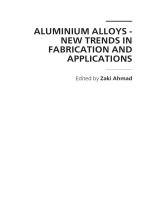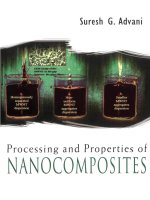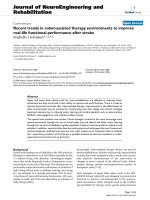RECENT TRENDS IN PROCESSING AND DEGRADATION OF ALUMINIUM ALLOYS_1 docx
Bạn đang xem bản rút gọn của tài liệu. Xem và tải ngay bản đầy đủ của tài liệu tại đây (38.54 MB, 232 trang )
RECENT TRENDS IN
PROCESSING AND
DEGRADATION OF
ALUMINIUM ALLOYS
Edited by Zaki Ahmad
Recent Trends in Processing and Degradation of Aluminium Alloys
Edited by Zaki Ahmad
Published by InTech
Janeza Trdine 9, 51000 Rijeka, Croatia
Copyright © 2011 InTech
All chapters are Open Access distributed under the Creative Commons Attribution 3.0
license, which permits to copy, distribute, transmit, and adapt the work in any medium,
so long as the original work is properly cited. After this work has been published by
InTech, authors have the right to republish it, in whole or part, in any publication of
which they are the author, and to make other personal use of the work. Any republication,
referencing or personal use of the work must explicitly identify the original source.
As for readers, this license allows users to download, copy and build upon published
chapters even for commercial purposes, as long as the author and publisher are properly
credited, which ensures maximum dissemination and a wider impact of our publications.
Notice
Statements and opinions expressed in the chapters are these of the individual contributors
and not necessarily those of the editors or publisher. No responsibility is accepted for the
accuracy of information contained in the published chapters. The publisher assumes no
responsibility for any damage or injury to persons or property arising out of the use of any
materials, instructions, methods or ideas contained in the book.
Publishing Process Manager Petra Nenadic
Technical Editor Teodora Smiljanic
Cover Designer Jan Hyrat
Image Copyright McIek, 2011. Used under license from Shutterstock.com
First published November, 2011
Printed in Croatia
A free online edition of this book is available at www.intechopen.com
Additional hard copies can be obtained from
Recent Trends in Processing and Degradation of Aluminium Alloys, Edited by Zaki Ahmad
p. cm.
ISBN 978-953-307-734-5
Contents
Preface IX
Part 1 Casting and Forming of Aluminium Alloys 1
Chapter 1 Aluminium Countergravity
Casting – Potentials and Challenges 3
Bolaji Aremo and Mosobalaje O. Adeoye
Chapter 2 Intermetallic Phases Examination in
Cast AlSi5Cu1Mg and AlCu4Ni2Mg2
Aluminium Alloys in As-Cast and T6 Condition 19
Grazyna Mrówka-Nowotnik
Chapter 3 Rotary-Die Equal Channel Angular Pressing Method 41
Akira Watazu
Part 2 Welding of Aluminium Alloys 61
Chapter 4 Welding of Aluminum Alloys 63
R.R. Ambriz and V. Mayagoitia
Chapter 5 Prediction of Tensile and Deep Drawing
Behaviour of Aluminium Tailor-Welded Blanks 87
R. Ganesh Narayanan and G. Saravana Kumar
Part 3 Surface Treatment of Aluminium Alloys 113
Chapter 6 Laser Surface Treatments of Aluminum Alloys 115
Reza Shoja Razavi and Gholam Reza Gordani
Chapter 7 Microstructural Changes of Al-Cu Alloys After
Prolonged Annealing at Elevated Temperature 155
Malgorzata Wierzbinska and Jan Sieniawski
VI Contents
Chapter 8 PIII for Aluminium Surface Modification 175
Régulo López-Callejas, Raúl Valencia-Alvarado,
Arturo Eduardo Muñoz-Castro, Rosendo Pena-Eguiluz,
Antonio Mercado-Cabrera, Samuel R. Barocio,
Benjamín Gonzalo Rodríguez-Méndez and
Anibal de la Piedad-Beneitez
Chapter 9 Optimizing the Heat Treatment
Process of Cast Aluminium Alloys 197
Andrea Manente and Giulio Timelli
Part 4 Mechanical Behavior of
Aluminium Alloys and Composites 221
Chapter 10 High Strength Al-Alloys:
Microstructure, Corrosion and Principles of Protection 223
Anthony E. Hughes, Nick Birbilis, Johannes M.C. Mol,
Santiago J. Garcia, Xiaorong Zhou and George E. Thompson
Chapter 11 Mechanical Behavior and Plastic Instabilities of
Compressed Al Metals and Alloys Investigated with
Intensive Strain and Acoustic Emission Methods 263
Andrzej Pawelek
Chapter 12 Aluminum Alloys for Al/SiC Composites 299
Martin I. Pech-Canul
Part 5 Corrosion and Mechanical
Damage of Aluminium Alloys 315
Chapter 13 Effects of Dry Sliding Wear of Wrought
Al-Alloys on Mechanical Mixed Layers (MML) 317
Mariyam Jameelah Ghazali
Chapter 14 Comparison of Energy-Based and
Damage-Related Fatigue Life Models for
Aluminium Components Under TMF Loading 329
Eichlseder Wilfried, Winter Gerhard,
Minichmayr Robert and Riedler Martin
Chapter 15 Deformation Characteristics of
Aluminium Composites for Structural Applications 347
Theodore E. Matikas and Syed T. Hasan
Chapter 16 Corrosion Behavior of
Aluminium Metal Matrix Composite 385
Zaki Ahmad, Amir Farzaneh and B. J. Abdul Aleem
Contents VII
Chapter 17 Interrelation Between Failure and Damage Accumulation
in the Pre-Fracture Zone Under Low-Cycle Loading 407
Vladimir Kornev, Evgeniy Karpov and Alexander Demeshkin
Part 6 Microstructures, Nanostructures and Image Analysis 423
Chapter 18 Nanostructure, Texture Evolution and
Mechanical Properties of Aluminum Alloys
Processed by Severe Plastic Deformation 425
Abbas Akbarzadeh
Chapter 19 Statistical Tests Based on the
Geometry of Second Phase Particles 459
Viktor Beneš, Lev Klebanov, Radka Lechnerová and Peter Sláma
Chapter 20 Microstructural Evolution During the
Homogenization of Al-Zn-Mg Aluminum Alloys 477
Ali Reza Eivani, Jie Zhou and Jurek Duszczyk
Preface
Aluminum is the second most plentiful element on the earth and it became a
competition in 19
th
century. The huge demand of aluminum is projected to get 70
million tons, over 30 millions being obtained from recycled scrap. The scope of
aluminum ranges from household to space vehicles. Dramatic advances in
casting,welding,forming and eco friendly methods of production have made
aluminum and aluminum alloys highly attractive candidate for automotive and
aerospace industry, because of their wide range of attributes such as high strength,
resistance to corrosion, low density, high reflectively, high ductility and proven
reliability. The developments in the last two decades have been revolutionary and well
documented both for wrought, heat treatable and non-heat treatable alloys. New
developments in methods of casting, forming, welding, environmental degradation,
grain refinement and particle size at nano and micro scale have made big impact on
their demand for space and automotive industry.
Despite serious competition from composites, aluminum alloys are still the king in
these industries, as exemplified by 777 Airbus. Aluminium is a very versatile metal
and can be cast in any form, stamped, forged, machine, brazed and resin bonded.
Substantial evidence has been gathered on formability which affects the structural
integrity of the components. The demand on quality and integrity of welding is
increasing on military and commercial aircraft. This includes improved toughness,
lower weight and increased resistance to corrosion fatigue. The progress made in
welding, analysis of different techniques and their impact on micro structural
characteristics has been discussed in several chapters in the hinder the section
“welding, casting and forming”. Ambriz Richardo has discussed this topic whereas
Saravana Kumar has provided valued information on tailored blanks and deep
drawing behavior of aluminum alloys. Because of high plastic strain, levels, rigid
strength requirements and high quality controls are required for forming processes
ranging from single to multiple stage because of increasingly dynamic and
competitive market demands which includes outstanding toughness and a high
resistance to corrosion fatigue. Various casting process such as direct chill casting,
rotary die equal channel angular processing, counter gravity casting and centrifugal
casting is described by Aremo Bolaji, Watazu Akira and others have shown new
X Preface
dimensions in the field of casting. Dramatic changes in surface treatment have
proved highly effective in the life cycle of aluminum alloys as shown by Shoja Razavi
Reza, Wierzbinska Malgorzata, Lopez-Cellajas Regulo, Metikas Theodore and
Morwka-Nowotnik Grazyna have added new data to new information.
Improvements in surface topography and stability are only achieved successfully by
combining electrochemistry, microstructures and the role of micro/nano particles new
methods of surface modifications are described by Akbarzadeh Abbas, Timelli Giulio
and Kornev Vladimir. Corrosion is a serious thread to aluminum alloys and
aluminum based metal matrix composites reinforced by silicon carbide. A brief
mechanism of corrosion of composited is given by Zaki Ahmad. Environmental
damages such as corrosion fatigue in aluminum alloys and their mechanism have
been described by Ghazali Mariam and Eichlseder Wilfried. The principle behind the
chapters in book was an analysis of the procedures such as casting, forming, welding
and environmental degradation which have a strong bearing on the integrity of
aerospace structures and automotive. The authors have addressed the problems of
grain refinement, micro segragation, casting defects, crack growth, weld defects to
show to what levels the aluminum alloys have been technically elevated. The
chapters were selected on a rigid criteria of which novelty and new approaches were
the main pillars.
I hope the book would be very useful for practicing engineers, technicians, senior
students and all those interested in aluminum alloys in particular the technical staff of
aerospace, automotive and defense industry. Chapters on casting, welding and others
could be used to support their textbook at a graduate level. This book is profusely
illustrated to make the concepts clear to the readers.
While editing the book I had the problems of shifting from one country other which
prolonged my editing work for which I apologize.
I thank Mr. Mishaal Ahmed (my grandson), Manzar Ahmed, Intesar Ahmed,
Shamsujehan, Huma Sabir and Abida Sultana, they provided me with the mental
support for the work not the least, the spirit of my beloved dead son Intekhab Ahmed
drove me through very hard times while reviewing the chapters.
I am very grateful to KFUPM who gave me the moral support. I am specially indebted
to Dr Faleh Al Sulaiman vice rector of technology at KFUPM, Dr Nasir Aqeeli, Mr
Faheemuddin and Mr Abdul Aleem of M.E department of KFUPM. I also thanks Dr
M. Budair rector of Al-Jouf University for his moral support.
In the end I thank the Al Mighty to give me the moral courage to undertake the
responsibility. I am grateful to InTech publisher for giving me the honor of being the
chief editor of this book.
Preface XI
I would like to finish this preface by the famous saying of Albert Einstein “Any fool
can make things bigger, but it takes a genius to make the things smaller”. I hope this
small book would prove an asset in pursuit of knowledge on aluminum alloys.
Dr. Zaki Ahmad (Professor Emeritus)
C. Eng, UK, FIMMM, UK
King Fahd University of Petroleum and Minerals, Dhahran
Saudi Arabia
Part 1
Casting and Forming of Aluminium Alloys
1
Aluminium Countergravity Casting –
Potentials and Challenges
Bolaji Aremo
1
and Mosobalaje O. Adeoye
2
1
Centre for Energy Research & Development, Obafemi Awolowo University, Ile-Ife,
2
Department of Materials Science and Engineering, Obafemi Awolowo University, Ile-Ife,
Nigeria
1. Introduction
Counter-gravity casting, also called vacuum casting, is a mould filling technique in which low
pressure created inside a mould cavity, causes prevailing atmospheric pressure on the melt
surface to bring about an upward or counter-gravity movement of the melt into the mould
cavity. The process was patented in 1972 by Hitchiner Manufacturing (Lessiter & Kotzin, 2002)
and different variants of the process had evolved over the years. Greanias & Mercer (1989)
reported a novel valve system that could potentially increase throughput by allowing mould
disengagement prior to solidification while Li et al (2007) have developed a multifunctional
system aimed at aggregating different variations of the technology into a single equipment.
The unique mould filling approach of the countergravity casting technique confers on it a
set of unique advantages related to casting economics, defects elimination and attainment of
net-shape in cast products. Such desirous attributes has ensured the growing importance of
the technology, especially in power and automotive applications. A testament to the rising
profile of this casting technique is its adoption in the production of a range of parts such as
compressor wheels for turbo-chargers (TurboTech, 2011), automotive exhaust manifolds
(Chandley, 1999) and a high-volume production (130,000 units/day) automotive engine
Rocker Arm (Lessiter, 2000).
The growing importance of this casting technique in some metal casting sectors
notwithstanding, there is scant awareness and interest in many mainstream casting spheres.
This chapter thus seeks to present a technology overview of the countergravity casting
technique. The shortcomings of conventional processes are highlighted alongside the unique
advantages of the countergravity technique. Challenges of the countergravity technique are
also presented with discussion of efforts and prospects for their redemption.
2. Description of the countergravity casting process
The basic process steps for the vacuum casting process are presented as follows. In the
diagram in figure 1, a preheated investment mould with an integrated down-sprue (fill
pipe) is positioned in the moulding flask.
The sprue, with a conical-shaped intersection point with the rest of the mould, pokes
through and sits in the conical depression of the lock-nut. The “square” fit of the two,
depicted in figure 2, ensures a sealing of the flask interior from the external environment.
Recent Trends in Processing and Degradation of Aluminium Alloys
4
Fig. 1. Typical setup of the countergravity casting process
Fig. 2. Down sprue, with conical base (a) is integrated with the rest of the investment mould
“tree” (c). The assemble rests inside the conical depression of the lock-nut (b)
Aluminium Countergravity Casting – Potentials and Challenges
5
The otherwise solid investment mould is made permeable by a single opening at its apex.
This opening effectively connects the mould cavity with the interior space of the moulding
flask, making it an extension of the moulding flask and enabling its evacuation along with
the rest of the flask. The flask lid hosts the casting valve, a connecting hose to the vacuum
system and lid locking mechanism. The electrical resistance furnace melts the aluminium
charge, usually by a superheat of about 40 °C above the melting temperature (660 °C) of
aluminium to reduce melt viscosity and ease melt up-flow into the mould. During
countergravity casting, the moulding flask with the mould assembly inside, is placed on the
furnace lid with the down-sprue poking through a hole in the furnace lid.
The vacuum system evacuates the moulding flask and the ensuing low pressure thus
created causes ambient atmospheric pressure on the melt to push up the molten metal, up
inside the mould. See figure 3.
Fig. 3. The evacuation of the moulding flask (a) also evacuates the investment mould cavity.
This causes molten aluminium to rise up into the mould cavity (b)
Apart from investment material, the mould could be a metal mould or a ceramic mould. The
vacuum system is calibrated so that just the right volume of melt flows inside the mould for
a period long enough for the melt to solidify. The vacuum is released after allowing enough
time for melt solidification in the mould cavity. This allows un-solidified melt along the
sprue length to be flow back into the furnace. The illustration in figure 4 shows the vacuum
being maintained until the cavity is completely filled. Vacuum pressure is then released
causing un-solidified melt in the sprue to flow back into the furnace
3. Conventional techniques and casting defects
Conventional gravity- or pressure-assisted aluminium metal casting techniques like sand
casting, investment casting and die casting are fraught with problems. These include gas
defects, melt oxidation, shrinkage defects and pouring defects. Defects are naturally
undesirable because they can result in low strength, poor surface finish and high number of
rejects in a batch of cast products.
Recent Trends in Processing and Degradation of Aluminium Alloys
6
Fig. 4. The vacuum is maintained until the cavity is completely filled. Vacuum pressure is
released causing un-solidified melt to flow back into the furnace
3.1 Gas defects
Molten aluminium is particularly susceptible to adsorbing significant quantities of hydrogen
gas from atmospheric moisture, which leads to a high concentration of dissolved hydrogen
in the melt. This may be further exacerbated by alloying element like magnesium which
may form oxidation reaction products that offer reduced resistance to hydrogen diffusion
into the melt (Key to Metals, 2010). This causes blow holes and gas porosity which combine
to reduce strength of the cast part. The micrograph in figure 5 shows a blow hole defect, it
can appear at any region of the cast microstructure and is exacerbated by damp mould
materials which give off steam during casting. Figure 6 shows gas porosity defects in an
aluminium casting, these are much smaller than blow holes and tend to form in clusters
around the region of the grain boundaries.
3.2 Melt oxidation
Oxidation of the melt is another severe defect suffered by aluminium alloy castings. The
elevated melt temperature promotes easy oxidation of the aluminium by ambient oxygen.
The aluminium oxide thus formed is an undesirable non-metallic inclusion. Considerable
efforts, through the use of in-mould filters, protected atmosphere, or alloying additions are
often needed to reduce oxide formation and entrainment in the mould.
Aluminium Countergravity Casting – Potentials and Challenges
7
Fig. 5. A Blow hole defect in an aluminum casting at 100× magnification
Fig. 6. Gas porosity in aluminium casting at 1000× magnification
Recent Trends in Processing and Degradation of Aluminium Alloys
8
3.3 Shrinkage
Shrinkage is the natural consequence of liquid to solid transformation of the melt during
cooling and is common in most metals. Shrinkage is particularly severe in aluminium alloys.
In aluminium alloys, the volumetric shrinkage ranges from 3.5% to 8% (Kaufman and Rooy,
2004). This manifests as shrinkage cavities in larger portions of the casting.
This is often counteracted by strategic placement of risers. Figure 7 shows the typical
appearance of volumetric shrinkage defect in an aluminium section.
Fig. 7. Typical appearance of volumetric shrinkage defect in an aluminium section
3.4 Pouring defects
During pouring of the melt, there is considerable splashing and sloshing about of the melt.
This entrains significant quantities of air and non-metallic inclusions in the mould. Such
entrained material degrades casting quality. This problem is often mitigated by incorporation
of complex gating systems designed using advanced Computational Fluid Dynamics (CFD)
modules. Such casting simulation software is able to predict and avoid bubble streams in
metals castings (Waterman, 2010).
Some of the problems outlined above have been resolved by advancements in pressure die
casting, improved investment casting techniques and centrifugal casting. These techniques
individually solve some, but often not all of the problems with gravity-assisted pour of an
air-melt. For instance, in conventional die casting, melt is sprayed at high velocity into the
die and cavity-atmosphere tends to be admixed and entrapped in castings during the
Aluminium Countergravity Casting – Potentials and Challenges
9
turbulent cavity-fill (Jorstad, 2003). The process of air melting and pouring also inevitably
introduces oxides, formed during melting, into the cast product. Significant inclusions
segregation at grain boundaries are thus very common with gravity assisted sand casting.
4. Advantages of the countergravity casting technique
Numerous advantages for metal casters are endemic to the countergravity casting
technique. These may be broadly categorized into defect reduction and elimination and
casting economics.
4.1 Cleaner melt
For aluminium alloys, metal oxides formed and aggregated on the melt surface can be by-
passed by taking clean melt from below the surface. The practice of de-slagging using a
hand ladle or metal rod to scoop the slag layer off the melt surface unavoidably leaves
pieces of slag in the melt which ultimately flows into the mould during casting.
Countergravity casting also results in improved melt cleanliness, due to reduced turbulence
during mould filling (Druschitz and Fitzgerald, 2000).
4.2 Elimination of shrinkage defect
Shrinkage is virtually eliminated in the countergravity casting technique. This is because a
constant supply of fresh melt is maintained in the mould during casting. Hence, as portions
of the mould begin to solidify, the down-sprue is the last to start solidifying. The reservoir
of molten melt in the crucible acts as a riser, ensuring a steady supply of melt into the mould
during solidification. This effectively eliminates the need for risering. Figure 8 shows the
cross-section of a countergravity cast rod. The absence of volumetric shrinkage defect is
evident from the convex meniscus at the top of the rod section.
4.3 Simplified gating system
In the countergravity technique, the gating system is considerably simplified as is depicted
in figure 9. It consists merely of branches of flow channels emanating from the central sprue.
This simplicity is possible because the interior of the mould is actually an extension of the
vacuum system. The high pressure differential between the mould interior and the
atmospheric pressure ensures that the molten metal will completely permeate every cavity
in the mould. Complex in-gates, depending on gravity flow of melt are thus not needed.
This considerably simplifies the mould design.
4.4 Economical
Countergravity technique significantly decreases the amount of gates that must be re-melted
(Flemings et al, 1997). This was actually one of the original goals of the countergravity
technique at its inception. Fettling time and costs are reduced while high quality melt is
judiciously used.
5. Potentials and applications of the countergravity casting technique
The countergravity technique has numerous potentials, derivable from its advanatges over
the conventional metal casting techniques. As such it is gradually making in-roads into
traditional investment casting applications and also in novel materials production.
Recent Trends in Processing and Degradation of Aluminium Alloys
10
Fig. 8. Cross-section of a countergravity cast rod showing the absence of volumetric
shrinkage defect as evident from the convex meniscus at the top of the rod
Fig. 9. An investment mould “tree“, simplified structure is characteristic of the countergravity
technique
Aluminium Countergravity Casting – Potentials and Challenges
11
Fig. 10. Ceramic mould at 400× magnification shows heavy segregation of impurities at the
grain boundaries
Fig. 11. Countergravity cast specimen at 400× magnification. Significant reduction of
impurities at the gain boundaries indicates lesser intake of impurities from the melt
Recent Trends in Processing and Degradation of Aluminium Alloys
12
5.1 Scrap reduction and scrap usage
Due to the intrinsic ability of the casting technique to produce cleaner castings, it is more
adaptable to the use of scraps and foundry returns. These types of foundry feedstock
contain significant admixed impurities like moulding sand and oxide inclusions. Such scrap
metals produce significant slag which float on the melt surface.
The process of taking the melt can actually be used to pump clean metal below the melt
surface. Figures 10 and 11 respectively show the micrographs of gravity-pour ceramic
mould cast samples and countergravity cast samples of scraps of aluminium foundry
returns. The microstructure shows more segregation of melt impurities in the gravity-pour
ceramic mould, while the vacuum cast specimen shows significant reduction in impurities.
5.2 Net-shape casting
The countergravity technique is well suited for producing net-shape cast products. It is
especially suited for thin-walled sections and intricate details due to its excellent mould
filling. This is possible due to the virtual elimination of shrinkage defects in the
countergravity casting technique. Near net-shape castings of even higher temperature
alloys, such as steels are possible. Such has been reported by Chandely et al (1997) in the
production of thin-walled steel exhaust manifolds.
5.3 Improved strength
Countergravity cast products have improved strength over green sand and ceramic
mould specimens. The technique may be thus deployed in the production of high strength
parts hitherto produced by forging. High Counter-Pressure Moulding, a proprietary
variant, has been reported to exhibit the same strength characteristics as forging in alloy
wheel production, at little more than the price of cast wheel (Alexander, 2002).
Countergravity techniques are increasingly becoming the preferred choice for the
production of alloy wheels because of the added advantage of design flexibility over
forging processes. Furthermore, the Cosworth process, which achieves countergravity
melt flow by means of an electromagnetic pump, has been successfully used for high
strength structural components for air frames, gun cradles, and air tanker re-fuelling
manifolds (Bray, 1989).
Griffiths et al (2007) observed that countergravity filling method produced higher values of
the Weibull modulus than conventional gravity mould filling methods. This is a pointer to
the reduced variability of strength achievable in the countergravity technique.
5.4 Economical use of melt
There are often considerable wastages of melt in more conventional casting techniques due
to provisions made for risering and complicated in-gates.
This also results in considerable fettling time and costs. Such wastages are virtually
eliminated in countergravity casting since there is no need for risers and complex in-gates
are not necessary.
5.5 Production of metal matrix composites
Use of the countergravity casting technique is gradually branching into novel materials
production. An emerging field of application is the production cast Metal Matrix
Aluminium Countergravity Casting – Potentials and Challenges
13
Composites (MMC) which can be cast into complex, intricate geometries. These materials
have found applications in diverse fields, from high quality reflective mirrors to optical
and laser equipment (O’Fallon Casting, 2009). There has been increased interest in the use
of cast aluminium/silicon carbide MMC for optoelectronics packaging due to its
compatible coefficient of thermal expansion, high thermal conductivity, and potential to
produce parts at low cost (Berenberg, 2003). In ring laser gyros, these MMCs are
displacing traditional favourites like beryllium and stainless steel in the production of
dimensionally stable mirrors that can withstand extreme thermal cycling (Mohn and
Vukobratovich, 1988).
6. Challenges and limitations of countergravity casting
The afore-mentioned advantages notwithstanding, the process has some challenges militating
against its wide-spread deployment.
6.1 Equipment cost
Spada (1998) reported the cost of countergravity mould and handling equipment to be
typically between $50,000 to $1.25 million depending on complexity. Present day prices
would naturally be much higher. This is so because the proper utilisation of a
countergravity casting equipment requires an ecosystem of support facilities. These include
high-temperature mould pre-heating ovens, mould and moulding flask positioning units,
and sophisticated vacuum control systems. These added facilities add to the cost of setting
up and operation of the technique. In some instances, licensing fees may also apply, further
raising up the cost.
6.2 Size restriction of products
Countergravity casting is typically restricted to smaller sized components, usually less than
50 kg. This is because the moulding flask tend to be small, to allow for proper operation of
the vacuum system. Larger flasks are more difficult to evacuate and maintain at desired
partial vacuum.
6.3 Mould and sprue pre-heat temperature
It is essential for the mould and the sprue to be adequately heated prior to carrying out
countergravity casting. The pre-heat prevents chilling of the melt as it flows up from the
crucible. Improperly pre-heated sprue and mould will cause increased melt viscosity and a
tendency for the melt to get stuck in the sprue or incomplete mould filling. Figure 12 shows
premature solidification of melt inside the sprue due to inadequate pre-heat of the mould
and sprue assembly.
6.4 Vacuum control
Proper control of vacuum pressure is paramount in countergravity casting. Too much
vacuum will result in splatter of melt inside the moulding flask due to over-filling of the
mould cavity. Loss of vacuum during casting is also a real problem for countergravity
technique. This may be caused by improperly closed lid, damage to or cracks in the
moulding flask, or a poor seal between the recess of the lock-nut and the conical connection









